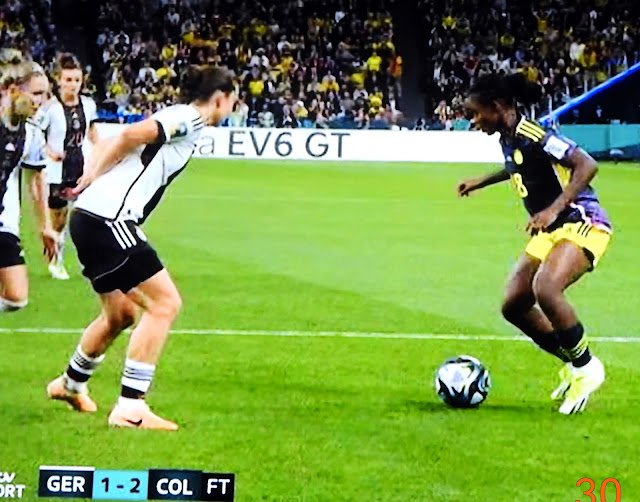It's 102 years since British feminists banned women's football for 50 years because of the risk of injuries - and now BBC Radio 4's male presenter tried to do the same by wilfully using wrong statistics!
Linda Caicedo, who had already won over ovarian cancer, thought taking on Germany was a piece of cake. Which it was! Funnily, when you look up 'ovarian cancer' you're ,as usual, told the main risk factors are old age and obesity. However, Linda got it at 15 and doesn't look too obese to me. She also seems to take care of her fitness.Keira Walsh, whom BBC used as an excuse for spreading its anti-football poison, actually didn't even have an ACL.
The PC myth that ACL injuries are more common among females, Peter Klevius punctured already in the 1980s when he realized that this was due to sex segregation - not sex. Because sex segregation made many girls physically much less active than boys, this resulted in bodies in puberty that weren't equally prepared for taking on football as boys, and therefore led to more injuries when they eventually did. Not because of the female body but because of sex segregation. There are no studies showing that girls who played football or otherwise fooled around with their bodies from early childhood on and then ended up as professionals, should have more ACL injuries than males. Moreover, most ACL injuries happen without contact with other players.
2022 study:
Background: The impact of anterior cruciate ligament reconstruction (ACLR) on the performance and career of professional soccer players has not been extensively investigated.
Purpose: To evaluate in professional European soccer players (1) the ACL injury incidence, (2) the return-to-play (RTP) rate and time after ACLR, (3) career survival and athlete performance in the first 3 postoperative seasons after RTP, (4) factors likely related to different outcomes after ACLR, and (5) any related differences between the top 8 European soccer leagues.
Study design: Descriptive epidemiology study.
Methods: Included were professional soccer players in the top 8 European Soccer leagues (Serie A [Italy], Premier League [England], Ligue 1 [France], LaLiga [Spain], Bundesliga [Germany], Jupiler Pro League [Belgium], Liga NOS [Portugal], and Premier Liga [Russia]) who sustained an ACL injury during seasons 2014 to 2015, 2015 to 2016, and 2016 to 2017. Data were retrieved from publicly available online sources. Outcomes were evaluated based on player age (<25 years, 25-30 years, and >30 years), position (goalkeeper, defender, midfielder, and forward), affected side (dominant vs nondominant), and league.
Results: Overall, 195 players sustained an ACL injury, for a mean annual ACL injury incidence of 1.42%. The RTP rate was 95%, with a mean RTP time of 248 ± 136 days. Within the third postoperative season, 66 players (36%) competed in a lower level national league, and 25 (13.6%) ended their careers; a significant reduction in the mean minutes played per season was found in all 3 postoperative seasons. Player age correlated significantly with reduction in performance or recovery from an ACL injury. No significant correlation was found between postoperative player performance and affected side, position, league, or time to RTP.
Conclusion: A substantial ACL injury incidence was found in top European elite soccer players; however, a high RTP rate in a reasonable time was seen after ACLR. Nevertheless, professional soccer players experienced a short-term decline in their performance.
2019 study:
Objective: To evaluate sex differences in incidence rates (IRs) of anterior cruciate ligament (ACL) injury by sport type (collision, contact, limited contact, and noncontact).
Data sources: A systematic review was performed using the electronic databases PubMed (1969-January 20, 2017) and EBSCOhost (CINAHL, SPORTDiscus; 1969-January 20, 2017) and the search terms anterior cruciate ligament AND injury AND (incidence OR prevalence OR epidemiology).
Study selection: Studies were included if they provided the number of ACL injuries and the number of athlete-exposures (AEs) by sex or enough information to allow the number of ACL injuries by sex to be calculated. Studies were excluded if they were analyses of previously reported data or were not written in English.
Data extraction: Data on sport classification, number of ACL injuries by sex, person-time in AEs for each sex, year of publication, sport, sport type, and level of play were extracted for analysis.
Data synthesis: We conducted IR and IR ratio (IRR) meta-analyses, weighted for study size and calculated. Female and male athletes had similar ACL injury IRs for the following sport types: collision (2.10/10 000 versus 1.12/10 000 AEs, IRR = 1.14, P = .63), limited contact (0.71/10 000 versus 0.29/10 000 AEs, IRR = 1.21, P = .77), and noncontact (0.36/10 000 versus 0.21/10 000 AEs, IRR = 1.49, P = .22) sports. For contact sports, female athletes had a greater risk of injury than male athletes did (1.88/10 000 versus 0.87/10 000 AEs, IRR = 3.00, P < .001). Gymnastics and obstacle-course races were outliers with respect to IR, so we created a sport category of fixed-object, high-impact rotational landing (HIRL). For this sport type, female athletes had a greater risk of ACL injury than male athletes did (4.80/10 000 versus 1.75/10 000 AEs, IRR = 5.51, P < .001), and the overall IRs of ACL injury were greater than all IRs in all other sport categories.
Conclusions: Fixed-object HIRL sports had the highest IRs of ACL injury for both sexes. Female athletes were at greater risk of ACL injury than male athletes in contact and fixed-object HIRL sports.
Peter Klevius wrote:
Peter Klevius obituary over the best ever: RIP, the worlds best football player, Lily Parr - and the next best, Pele.
Also read how climate change made human evolution possible in SE Asian volatile archipelago - not on a continent like Africa.
Also read how
two craniopagus twin girls born 2006 solved the "greatest mystery in
science" - and proved Peter Klevius theory från 1992-94 100% correct.
Although both scored more than 1,000 goals, Lily Parr did so in headwind!
No
one can be more vulnerable for female sexual beauty (i.e. heterosexual
attraction - ask women who know him) than Peter Klevius - and no one
male can be more ignorant about sexual beauty when seeing a woman
playing football and on the arena becoming human instead of woman. Just
like the early Christian St. Perpetua who said before she faced death on
the gladiator arena 203 AD: 'And I was stripped (for death), and I
became a (hu)man*', i.e. no longer fettered by womanhood/femininity.
* A time when a man was considered the only fully human.
A sport of nature - or a fact of nature?
Social
convention based on a commonsense reaction to the ‘palpable menace of
sexual desire among all human beings, and, most especially, to the known
seductiveness of women’ (i.e. heterosexual attraction) was, at
Tertullian’s* time, i.e. the latter part of the Second Century, shared
by pagans and Christians alike. According to Tertullian, it was a fact
of nature that women were seductive, and Christian baptism did nothing
to change this fact (Brown 1988: 68, 81). However, we are not informed
why the fact that women are seductive, necessarily should imply
restrictions on her. We might guess that a number of Tertullians
transferred to a modern Western secular city might have diverged in a
similar pattern of opinion as would contemporary people. If women were
defined by marriage, by its sexual and procreative roles and by the
sex-based labor assigned to married women, then their refusal of
marriage might move them into a category that transcended womanhood.
Only in the arena of martyrdom can we view these transcendent women
unfiltered by the lenses of male observers (McNamara 1985:104).
Perpetua, a Roman matron, faced the lions in Carthage on March 7, 203.
She recorded her experience in prison which led her to a new vision in
which all her mortal persona was burned away. An unknown spectator'
possibly (most probably) Tertullian , rescued these documents and
appended an eyewitness account of her death, resulting in an authentic
female voice recording the emergence of her 'autonomous spiritual being
from the cocoon of her womanhood' (McNamara 1985:105). Perpetua
renounced everything that made her a Woman. She stripped away the
emotions and the constraints of the feminine role she had once fully
played. On the night before her execution, she dreamed that she had
entered into the arena to fight the beasts. There she was confronted by a
certain “ill-favored -Egyptian" who challenged her to fight with him.
Also, there came to me comely young men, my helpers and aiders. 'And I
was stripped, and I became a man' (McNamara 1985:105).
At the
foot of the ladder lay a dragon of enormous size, and it would attack
those who tried to climb up and try to terrify them from doing so.
* Tertullian has been called "the father of Latin Christianity" as well as "the founder of Western theology".
Not "women's football" but human's football - or just football*!
*
You don't say about a child that s/he plays "children's football", do
you. If it's a girl you say 'she plays football' and if it's a Finnish
girl you say 'hän pelaa jalkapalloa', where 'hän' is a sexless personal
pronoun (as in most other language families except IE and semitic) and
therefore not translatable to the indoeuropean sex segregated s/he. And
when divided by biological sex then it should also say 'men's football',
right.
As Peter Klevius for long has stated,
evolutionary (i.e. biological) heterosexual attraction (the only
analytically relevant distinction between the sexes, according to Peter
Klevius - and islam) has to be "civilized" in our daily encounters - but
without islamic sex segregation*. And the tool for this was given 1948
with Art. 2 of the Universal Human Rights declaration (the world's most
translated document), which main purpose is to stand as the bedrock not
only for legislation but also as a bulwark against sexism hiding in
culture. In other words, we need to get rid of sex segregation. No
matter of biological sex one should be free to lead once life as one
wishes - which also means that you have the right to appear
"feminine"/"masculine" (whatever that means) without being in any way
criticized by e.g. Peter Klevius - as long as it's not part of
sexism/racism against others.
Lily Parr, the world's by far best* football player ever - no matter of sex!
*
If Marta (six times chosen as the world's best football player) when
she was at her best, had time travelled and played against Lily Parr she
would probably have outperformed her in dribbling although perhaps not
in kicking. However, that's not a fair comparison - just think if Lily
had stopped smoking and got the same training etc. possibilities as
modern top players! And compared to Lionel Messi, who as a teenager was
taken care of by the world's then best football club Barcelona FC, Lily
Parr got just the very opposite - a ban on her putting her feet on any
English football ground for the rest of her career!
Lily Parr was
born in St Helens in 1905 where she as a child learned to play football
in games with her brothers. At 5ft 10ins tall, Lily was said to have a
'fearless streak' and 'robust frame'. As a teenager, her first games
were with her local side, St Helens Ladies.
There was a growth in
interest in women's football in the late 19th century and early 20th
because of the huge popularity of men's football combined with the fact
that so many young women met football playing men in factories etc.
Dick, Kerr & Co was such a factory where women worked making munitions.
When in 1917 office worker Alfred Frankland saw the girls beating their male factory co-workers in an informal lunch-time match, he decided to be their manager, hence unleashing them on the general public, resulting in a game-changing and instantaneous success.
This really shows how sex segregation had kept girls/women back.
Dick, Kerr Ladies F.C. was one of the earliest known women's football teams, and remained in existence for some 50 years, from 1917 to 1965, playing 833 games, winning 759, drawing 46, and losing 28. Nettie Honeyball's team in 1895 was possibly the first.
The matches attracted anywhere from 4,000 to over 50,000 spectators per match. In 1920, Dick, Kerr Ladies defeated a French side 2–0 in front of 25,000 people that went down in history as the first international football game played by women. On the request of female physicians and others the English Football Association (FA) banned women from using fields and stadiums controlled by FA-affiliated clubs for 50 years (the rule was only repealed in 1971). There were 150 women's football clubs in 1921 when on 5 December same year the FA ban was announced.
Dick, Kerr’s Ladies was also the first female team to play wearing shorts.
'Big, fast and powerful', Lily Parr was said to 'take corner kicks better than most men' and she scored 'many goals with a left foot cross drive which nearly breaks the net', according to her profile in a programme of 1923. A team-mate described her as 'having a kick like a mule'.
There were 150 women's football clubs by 1921 when on 5 December the FA decided to ban females from playing on its members' grounds. As a consequence the women's game declined but Lily Parr and other female players continued to play on non-FA pitches.
Dick,
Kerr’s Ladies became Preston Ladies in 1926. Parr became a psychiatric
nurse at Whittington Hospital but continued to play for Preston, finally
ending her long playing career in 1951.
Why the "beautiful game" is also the hardest to master well
Although
Lily Parr was taller than the average woman, most of the best players
have been below average height, like Pele, Maradona, Marta, Messi,
Modric etc.. However, Ronaldo is 187 cm and a former top player like
Crouch is 203 cm. This just emphasizes the greatness of "the beautiful
game" - a sport that fits everyone, yet is the hardest of all sports to
master because it eliminates tools and hands while keeping the feet busy
with multitasking with running and manoeuvring while also controlling
the ball with the same feet.
The page below in this book made Peter Klevius wipe tears several times
How Sweden was an accomplish to the death of English football for women - and how Lily Parr & Co's heritage created the world's best football team in the 1970s in a forgotten rural setting in Sweden.
Peter
Klevius has written a book with an in depth analysis about the history
of England's hostility against women playing football. Although Sweden
played an important role behind the scene, this has never before been
scientifically scrutinized. It's hoped that Amazon will publish it so to
make its existence more visible. Peter Klevius was about to go for self
publishing but it seemed impossible to reach out in a meaningful way.
After all, it's all about supporting girös and women who want not only
to play football but also lo tead their lives as they wish without
sexism.
Perpetua: 'I saw a ladder of tremendous height made of bronze, reaching all the way to the heavens, but it was so narrow that only one person could climb up at a time. To the sides of the ladder were attached all sorts of metal weapons: there were swords, spears, hooks, daggers, and spikes; so that if anyone tried to climb up carelessly or without paying attention, he would be mangled and his flesh would adhere to the weapons.'

























































































































































































No comments:
Post a Comment